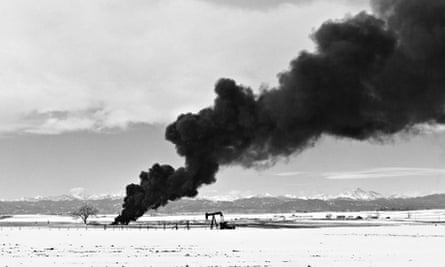"In common with many photographers," writes Robert Adams in the introduction to The Place We Live, his retrospective at Jeu de Paume in Paris, "I began making pictures because I wanted to record what supports hope: the untranslatable mystery and beauty of the world. Along the way the camera also caught evidence against, and I eventually concluded that this too belonged in pictures if they were to be truthful and useful."
For 45 years, Adams has photographed the American west, its prairies, skies and rivers, its creeping suburbs, highways and malls. He has recorded the epic natural beauty and palpable silence, and the defilement of that beauty by industrialisation, consumerism and pollution. His vision is essentially humane and thus old-fashioned, and both his pictures and writing – he has published several illuminating books of essays – are characterised by a sense of purpose you do not much encounter in photography any more.
His photographs are a kind of testimony: evidence of what has been lost and what remains. But they also ask us fundamental questions about how we live amid the contradictions and compromises of progress. For all that it carries, his work is restrained, suggestive rather than forceful, every black-and-white print at once a world in itself and part of a bigger narrative about man's destructive relationship with nature.
In the American west nature tends towards the epic, and occasionally Adams's small prints – often measuring just 15cmx15cm – echo the pioneering landscape photography of his namesake Ansell Adams. A case in point is North-east of Ketoa, Colorado, 1969, from his earliest series The Plains, 1964-1974 – a distant view of a small settlement beneath a vast, cloud-swept sky. The image introduces the element of silence that is a constant in Adams's work. As he once put it, writing of the great plains: "There is everywhere silence – a silence in thunder, in wind, in the call of doves, even a silence in the closing of a pick-up door." His pictures urge you to listen as well as look closely. In another early series, The New West, 1967-1971, a woman's profile is silhouetted in the window-frame of a prefab house, its stark geometry contrasted by the sweeping curve of a pathway from the front door.
You can see why Adams was included in the influential New Topographics show in 1975 alongside Lewis Baltz and Bernd and Hilla Becher. But as time goes by, he seems the least detached and neutral observer of that generation.

Divided into nine thematic headings, many of which refer to distinct regions – The Plains, From the Missouri West, The Pacific – the exhibition reveals Adams to be essentially an explorer with a camera. In series such as What We Bought, 1970-1974 or Our Parents, Our Children, 1979-1983, though, he records the cost, both physical and psychological, of American power. An image such as Burning Oil Sludge, north of Denver, Colorado, could in lesser hands be as viscerally overpowering as its title suggests. Instead, Adams's use of distance and scale makes the plume of black smoke arising from an austere plain both epic and intimate. In Our Parents, Our Children, he breaks with his own tradition to home in on people – often passersby – in close up, while the nearby nuclear weapons plant remains an ominous presence.
There are other surprises: a drab room in Ludlow, Missouri, made luminous by a square of sunlight falling on a bed through a curtained window; an old woman looking sternly at his camera in a car park in Denver; a Sunday School reading group gathered outside a church hall beneath a mountain range in Colorado. All suggest a deep attention to everyday life and its underlying rituals.
It is the land, though, that is Adams's abiding subject, whether untamed or defiled. He is a keen walker, and some of his greatest images have sprung from his walking thoughts. In his series Turning Back, 1990-2003, he contemplates the brutal destruction of the tall trees of the American north-west, where an abundance of large stumps testify to the cost of the practice known as clearcutting, which, despite much opposition, has decimated more than 90% of the original forest. "As I recorded these scenes", he writes, "I found myself asking many questions, among them: what of equivalent value have we inherited in exchange for the original forest? ... Does clearcutting originate in disrespect? Does it teach violence? Does it contribute to nihilism? Why did I almost never meet parents walking here with children?" Robert Adams is a humanist and a witness, an artist whose work insists on hope even as it records – and grieves for – a landscape that, in some instances, may soon only exist in his lucid photographs.

Comments (…)
Sign in or create your Guardian account to join the discussion